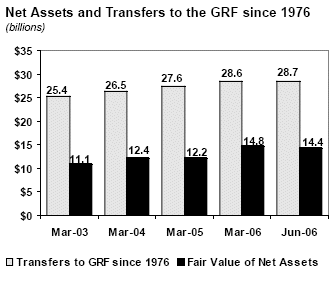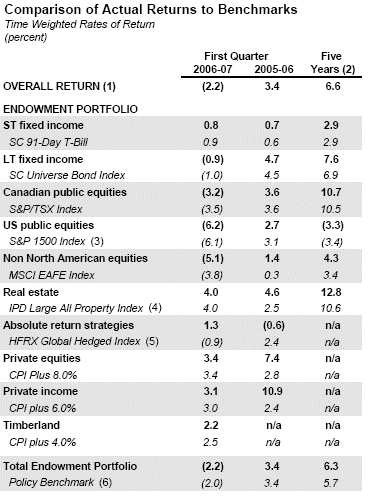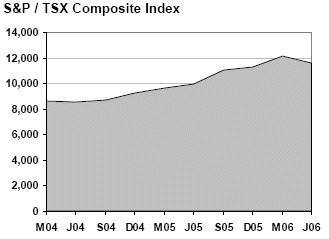| Index
Quarter
in Review
The Alberta Heritage Savings Trust Fund (the Fund) recorded investment
income of $172 million this quarter and unrealized capital losses
on investments of $493 million. This accounted for the Fund's
investment return of negative 2.2% for the first quarter of 2006-07.
The negative return results from a decline in world equity markets
this quarter following strong gains made last year. The decline
in stock markets reduced the fair value of the Fund's investments
resulting in unrealized capital losses and negative investment
returns. Of the total investment income of $172 million, $71 million
is retained in the Fund for inflation proofing while $101 million
is included in transfers to the General Revenue Fund (GRF) in
accordance with the Alberta Heritage Savings Trust Fund Act.
Overall, investment income was lower this quarter than the first
quarter of last year primarily due to lower net realized gains
from sale of securities and derivative transactions. In the first
quarter of last year, the Fund reported investment income of $321
million and unrealized capital gains of $95 million for a positive
return of 3.4%.
The Canadian stock market, represented by the S&P;/TSX Composite
Index, declined by 3.5% this quarter. A retreat in commodity related
stocks in early May followed by a global sell-off of equities,
higher interest rates and a weakening U.S. economy contributed
to the decline. However, Canada's economy continues to grow at
a healthy pace with relatively low unemployment, inflation and
interest rates.
The Canadian dollar increased in value over the quarter. At June
30, 2006, one U.S. dollar purchased $1.12 Canadian compared to
$1.17 Canadian at March 31, 2006. As a result, the value of the
Heritage Fund's U.S. equity investments decreased when translated
into Canadian dollars, resulting in lower investment returns.
Over the past three months, the U.S. market measured by the S&P;
1500 Index decreased by 1.7% in U.S. dollars and 6.1% when translated
into Canadian dollars. In the U.S., interest rates increased and
the housing market softened.
The non-North American market measured by the MSCI EAFE Index
decreased by 3.8% this quarter in Canadian dollars. However, the
global economy continues to grow, led by surging economic activity
in Asia and stronger conditions in Japan and Europe.

Summary
of Operations Since 1976
The Fund started in 1976. As disclosed in Note 6
to the financial statements, over the past 30 years, the Fund
has received contributions of $13.8 billion from the GRF and earned
investment income of $28.5 billion. The Fund has transferred $28.7
billion to the GRF to support spending on health care, education
and other services that Albertans value. Transfers to the GRF
are net of amounts retained for inflation proofing. The net assets
of the Fund represent the difference between the value of assets
held by the Fund and its liabilities. At June 30, 2006, the net
assets of the Fund totalled $13.6 billion on a cost basis and
$14.4 billion on a fair value basis.


Change
in Net Assets
The Fund accounts for its investments and investment income using
the cost basis of accounting. Investments and investment income
recorded on a cost basis exclude unrealized gains and losses.
Investment income on a fair value basis includes unrealized gains
and losses during the period. The investment loss on a fair value
basis for the three months ended June 30, 2006 was $321 million.



Investment
Income
The Fund recorded net income of $172 million this quarter. Interest,
dividends, real estate income and security lending income totalled
$154 million net of administrative expenses, compared to $119
million for the same period last year. Net realized capital gains
from sale of securities and derivative transactions totalled $18
million, compared to $202 million for the same period last year.


2006-07
Budget Estimates
Forecast
Income
The Fund's original budgeted income for the year totalling $917
million is included in the 2006-07 Government Estimates. Due to
the decline in equity markets this quarter, forecast income has
been reduced by $90 million to $827 million. On a consolidated
basis, after the elimination of income from Alberta provincial
corporation securities, the forecast income is $784 million.
Heritage Fund Investment
Income

Forecast
Transfers into the Fund
The 2006-07 Government Estimates provide for $1
billion to be transferred into the Fund from the government's
allocated surplus. An additional $250 million is provided for
under the Access to the Future Act (see Note 6 (a) to
the financial statements). These amounts will be recorded when
received.
Forecast
Inflation Proofing
In order to maintain the value of the Fund, the
2006-07 Government Estimates provided for inflation proofing of
the Fund in the amount of $242 million. The inflation proofing
forecast was subsequently increased by $41.4 million to $283.4
million due to an increase in the estimate of inflation for the
year. Of this amount, $70.8 million has been accrued for the quarter
ending June 30, 2006. The net income earned by the Fund, less
the amount retained in the Fund for inflation proofing is transferred
to the GRF.

Transfers
to the General Revenue Fund
At June 30, 2006, the outstanding transfers payable
to the GRF increased to $179 million from $78 million at March
31, 2006. The increase of $101 million is comprised of the Fund's
income for the quarter less the amount retained in the Fund for
inflation proofing.

Investments
Asset
Mix
The investment strategy is to invest in a diversified portfolio
to optimize long-term returns at an acceptable level of risk.
The policy asset allocation is reported in the Fund's 2006-09
business plan.
The long-term policy asset mix for the Fund consists of fixed
income securities (30%), public equities (45%), real estate (10%)
and alternative investments (15%). Alternative investments include
absolute return strategies, private equities, private income and
timberland. These investments are in a relatively illiquid asset
class and will require time to build up to their target asset
mix.
The actual investment mix for fixed income securities decreased
slightly to 32.8% from 33.3% at the beginning of the quarter while
public equity investments decreased to 49.5% from 50.6%. Real
estate investments increased to 10.3% from 9.6% of the Fund's
total investment portfolio. Absolute return strategies increased
to 4.1% from 3.8%. Private equity investments increased to 2.0%
from 1.7%. Private income investments increased to 0.9% from 0.6%.
Timberland investments were unchanged from the beginning of the
quarter at 0.4%.


Investment
Valuation
Investments and investment income are recorded on the financial
statements of the Fund at cost in accordance with government accounting
policies. The fair value of the Fund and its investments are provided
for information purposes. Management uses fair value to assess
the investment performance of the fund against market-based benchmarks.
The Fund's policy is to write down the cost of those securities
where the decline in value below cost is not considered temporary.
On a quarterly basis, management reviews the Fund's investment
portfolio to identify those securities where the fair value has
declined significantly below cost. Based on management's review,
writedowns totalling $10.2 million were recorded during the quarter
ended June 30, 2006.

Performance
Measurement
Heritage
Fund Rate of Return
The Fund posted an overall negative return of 2.2%
this quarter, compared to a positive return of 3.4% for the same
period last year. The negative return of 2.2% this quarter underperformed
the policy benchmark of negative 2.0% by 20 basis points.
The performance of the Fund is measured over the
long term. Over the past five-year time period, the Fund generated
a nominal annualized return of 6.6% compared to the expected nominal
long-term rate of return of 6.7%. The expected nominal annualized
return of 6.7% includes the real rate of return of 4.5% plus annualized
inflation of 2.2% over a moving five-year period.

The performance of the Fundís investments is measured
against various market-based indices. Value added by investment
management is accomplished through asset mix decisions and security
selection. The following sections describe the performance of
the Fundís major asset classes in relation to their benchmarks.



Fixed
Income Investments
The Scotia Capital (SC) Universe Bond Index measures
the performance of marketable Canadian bonds with terms to maturity
of more than one year. Over the past quarter, the SC Universe
Bond Index decreased by 1.0% while the short term SC 91-Day T-Bill
Index increased by 0.9%.


The Fund's actual rate of return over the quarter
from long-term Canadian fixed income securities was negative 0.9%,
10 basis points better than the benchmark SC Universe Bond Index.
Over five years, the return from long-term fixed income securities
was 7.6% or 70 basis points better than the benchmark of 6.9%.
The Fund's return from short-term securities was 0.8% and 2.9%
over three months and five years respectively. The Fund's fixed
income portfolio is internally managed through various pools and
through direct holdings.
At June 30, 2006, investments in deposits, bonds,
notes, short-term paper, provincial corporation debentures and
loans totalled 32.8% of total portfolio investments or $4.768
billion compared to 33.3% or $4.993 billion at March 31, 2006.

Canadian
Equity Investments
The Toronto Stock Exchange S&P;/TSX Composite Index,
which measures the performance of Canada's top companies, declined
by 3.5% for the quarter ending June 30, 2006.


The Fund's Canadian equity portfolio is held in
various investment pools, which are managed by internal and external
managers. Over the quarter, the Fund's actual return from Canadian
equities declined by 3.2%, 30 basis points better than the benchmark
return from the S&P;/TSX Index. Over five years, the Fund's return
from Canadian equities was 10.7%, 20 basis points better than
the benchmark return of 10.5%.
At June 30, 2006, investments in Canadian public
equities totalled 16.9% or $2.490 billion of the Fund investment
portfolio compared to 17.0% or $2.572 billion at March 31, 2006.

United
States Equity Investments
The U.S. equity market closed out the quarter posting
a negative return. The Standard & Poor's 1500 Index (S&P; 1500),
which measures the performance of the top 1,500 American companies,
decreased by 1.7% in U.S. dollars and 6.1% in Canadian dollars.


The Fund's actual rate of return over the quarter
from U.S. equities was negative 6.2% in Canadian dollars, or 10
basis points less than the S&P; 1500 Index. As a result of the
stronger Canadian dollar, the value of U.S. equity investments
decreases when translated into Canadian dollars, resulting in
lower investment returns. Over five years, the Fund's U.S. equity
portfolio returned negative 3.3%, 10 basis points better than
the benchmark.
At June 30, 2006, investments in U.S. equities totalled
16.4% or $2.368 billion of the Fund investment portfolio compared
to 16.8% or $2.513 billion at March 31, 2006.

Non-North
American Equity Investments
The Morgan Stanley Capital International Index for
Europe, Australasia, and the Far East (MSCI EAFE Index), measures
the performance of approximately 1,200 companies on 25 stock exchanges
around the world. Over the quarter, the index declined by 3.8%
in Canadian dollars.


The Fund's actual return from non-North American
equities was negative 5.1%, 130 basis points less than the MSCI
EAFE Index. Over five years, the Fund's non-North American equity
portfolio returned 4.3%, 90 basis points better than the benchmark
MSCI EAFE Index.
At June 30, 2006, investments in non-North American
equities totalled 16.2% or $2.361 billion of the Fund investment
portfolio compared to 16.8% or $2.520 billion at March 31, 2006.

Real
Estate Investments
The Fund's real estate investments are held in the internally
managed Private Real Estate Pool and the Foreign Private Real
Estate Pool. Real estate investments earned 4.0% over the quarter
and 12.8% over five years.

Approximately 51% of the real estate portfolio is
invested in office, 33% in retail, 11% in industrial and 5% residential.
Approximately 61% of the real estate holdings are located in Ontario,
28% in Alberta, 9% in Quebec and 2% in British Columbia.
At June 30, 2006, investments in real estate totalled
10.3% or $1.486 billion of the Fund investment portfolio compared
to 9.6% or $1.441 billion at March 31, 2006.

Absolute
Return Strategies
Absolute return strategy investments encompass a wide variety
of investments with the objective of realizing positive returns
regardless of the overall market direction. A common feature of
many of these strategies is buying undervalued securities and
selling short overvalued securities. Over the quarter, absolute
return strategies generated a positive return of 1.3%, 220 basis
points more than the benchmark Hedge Fund Research Inc. (HFRX)
Global Hedged Index.

At June 30, 2006, investments in absolute return
strategies totalled 4.1% or $604 million of total Fund investments
compared to 3.8% or $572 million at March 31, 2006.

Private
Equity Investments
At June 30, 2006, the private equities comprised 2.0% or $288
million of the Fund's total investment portfolio compared to 1.7%
or $258 million at March 31, 2006.
During the quarter, private equity investments returned 3.4%,
the same as the benchmark Consumer Price Index plus 8%.


Private
Income Investments
Private income investments comprised 0.9% or $134 million of
overall investments compared to 0.6% or $82 million at March 31,
2006. Private income investments returned 3.1% this quarter, 10
basis points better than the benchmark Consumer Price Index plus
6%.


Timberland
Investments
Timberland investments comprise 0.4% or $54 million of overall
investments compared to 0.4% or $56 million at March 31, 2006.
Timberland investments returned 2.2% this quarter, 30 basis points
less than the benchmark Consumer Price Index plus 4%.


Administrative
Expenses
Internal management expenses and external management fees are
deducted directly from the income earned by pooled investment
funds. Internal expenses include expenses recovered by Alberta
Finance for management of the Fund and investment pools. External
fees include fees charged to investment pools by external investment
managers based on a percentage of net assets under management
at fair value and committed amounts in the case of private equity
and private income pools.
The Fund's total administrative expenses for the quarter, including
amounts deducted from the investment income of the pooled funds,
amounted to $11.9 million or 0.08% of the Fundís net assets at
fair value compared to $10.4 million or 0.08% of net assets the
previous quarter.

Internal expenses increased by $0.101 million compared
to the same period last year. External fees increased by $1.465
million compared to the same period last year. The increase in
external manager fees is primarily due to the increases in the
fair value of investments.

|










